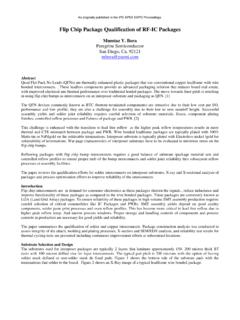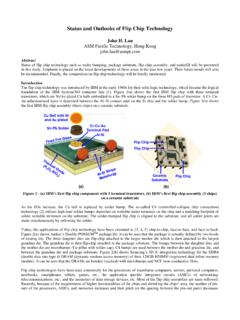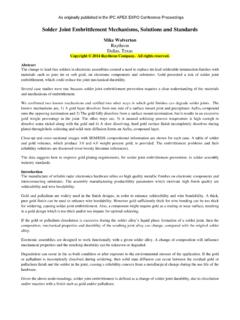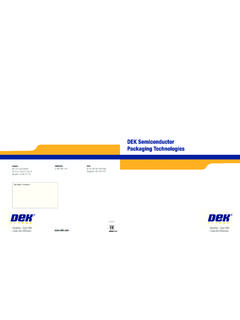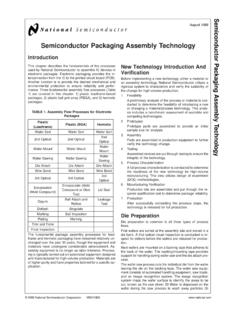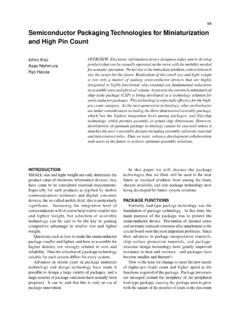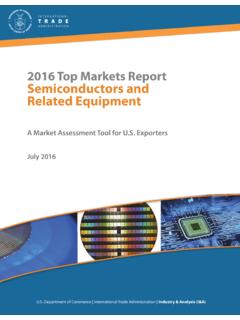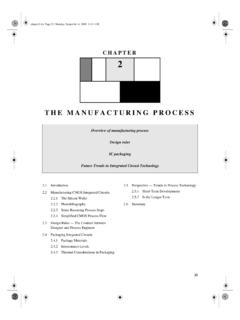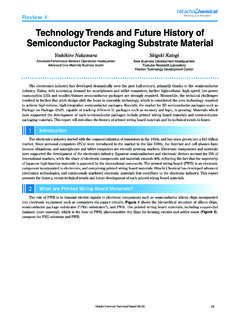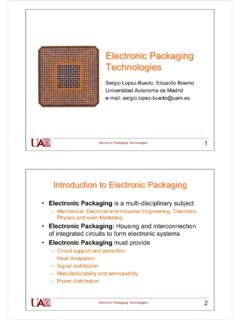Transcription of 3D IC INTEGRATION TECHNOLOGY …
1 3D IC INTEGRATION TECHNOLOGY development IN CHINA Wei Koh, Pacrim TECHNOLOGY Irvine, CA, USA ABSTRACT China s semiconductor foundry and microelectronic packaging industries are embracing the move to join 3D IC INTEGRATION TECHNOLOGY development with ample funding and rapid pace. An overview of the recent progress on the efforts in 3D IC INTEGRATION TECHNOLOGY development by the leading domestic companies and research institutes is provided here. Because China still lacks in infrastructure for advanced and modern front end of the line (FEOL), backend of the line (BEOL), and middle-end of the line (MEOL) process capabilities for 300mm wafers, development efforts on 3D IC INTEGRATION have many limitations to begin with.
2 The efforts adopted by some leading research institutes and back-end packaging assembly and test companies; however, appear to be quite ingenuous and pragmatic, by selecting more easier cutting-in research projects and processes that require less initial capital investment and infrastructural establishments. The pattern of latest development efforts can be divided into two major areas: 1) TSV materials, processing, and interconnection; 2) low-cost interposer and INTEGRATION assembly application in wafer level CSP packages for MEMS and sensors using small-sized wafers. The short term perspectives and longer term growth opportunities for China s indigenous development efforts on 3D IC INTEGRATION is summarized in conclusion.
3 Key words: TSV, 3D IC INTEGRATION , Interposer INTRODUCTION China Semiconductor Industry Before we discuss the red-hot topic of 3D IC INTEGRATION TECHNOLOGY , it is very helpful to review some background information and update on the status of China s semiconductor and back-end packaging assembly industry; how the industry s growth had been planned and cultivated to arrive at the present condition. Having established such bases of knowledge, it will then be much easier to understand and follow the approaches that the semiconductor and microelectronics assembly industries in China are taking to catch up with the 3D IC and TSV INTEGRATION technologies.
4 In recent years (2010/2011), China purchased over 40% of world s semiconductor ICs worth more than $100 billion for use in electronic products and systems. Yet, ironically, less than five percent of these ICs were made locally by domestic manufacturers. There is, therefore, a large IC consumption/production gap that amounted to $87 billion in 2010 for China [1]. In fact, as of mid-2012, none of the top 20 of world s semiconductors suppliers (including foundries) is Chinese. For the record, the top 10 semiconductor suppliers for 1H2012 according to IC Insights [2] are shown in Table 1. Four countries contributed to the first nine suppliers: USA, Korea, Japan, and the Republic of China (Taiwan).
5 China s top four semiconductor foundries--SMIC, Grace Semiconductor, HHNEC, and HLMC are not even on the list for the next 10 rankings. Furthermore, according to a recent forecast by SEMI on the 2013 semiconductor materials global market share [3], shown in Figure 1, China s share (as part of the Rest of Asia group of 12%) will be substantially behind its neighbors such as the Republic of China, Japan, and Korea. Per DigiTimes Research, the total China IC foundry industry output is estimated to be $ billion for 2012 [4]. Table 1. Top Semiconductor Suppliers in 1H2012 Company Country Rank Intel USA 1 Samsung Korea 2 TSMC ROC (Taiwan)
6 3 TI USA 4 Qualcomm USA 5 Toshiba Japan 6 Renesas Japan 7 SK Hynix Korea 8 Micron USA 9 ST Microelectronics Netherlands 10 Source: IC Insights McLean Report, Aug. 2012 As originally published in the SMTA Proceedings.
7 Figure 1 Global Market Share of Fab Materials (SEMI) Because of this huge IC consumption/production deficit suffered by China and the relatively small scale of China s semiconductor suppliers, for over a decade, the Chinese government and its domestic semiconductor industry have been trying very hard to increase the capability in IC design and production capacity for silicon wafer fabs in order to remedy this situation. The most recent 12-5 Plan (12th Five-year plan for 2011-2015) has eight focal industries for major upgrade and funding. These industries are: 1. IT and electronics manufacturing 2. Steel 3. Automotive 4. Biotechnology 5. Machine manufacturing 6.
8 Rare earth materials 7. Concrete materials 8. Aluminum industry For high-end manufacturing, semiconductor and IT are of course selected as the key focal industries for funding to encourage growth and expansion of indigenous, homegrown semiconductor wafer fabs and back-end assembly industries. However, for many years, the barriers that have been hindering China s advance in semiconductor TECHNOLOGY know-how and growth still existed: IC design capability China still lags behind the Western and Japanese/Korean players in designing sophisticated, advanced ICs based on leading-edge process nodes such as 30nm and below.
9 Such highly proprietary IP knowledge and experience cannot be gained overnight. Foreign players typically have prohibited the transfer or sales of advanced, leading-edge design and processing TECHNOLOGY to China. Insufficient availability of talents of experienced engineers and technical personnel to carry out leading-edge research and development ; domestic companies often rely on TECHNOLOGY collaboration with foreign players. To remedy this situation, China government has implemented the 863 Project on high-value, high-end advanced technologies that fund projects to research institutes and the industry to focus on research and development of next-generation TECHNOLOGY platforms such as Internet of Things and Cloud Computing.
10 Local companies are also more aggressive in requesting foreign partners to share or transfer their advanced IP and know-how in joint-venture investments. When the 3D IC INTEGRATION using TSV TECHNOLOGY came along in recent years, China sees it as a perfect opportunity and platform to further advance its semiconductor and backend packaging assembly industries. China Semiconductor Foundries Silicon wafer based CMOS TECHNOLOGY form the largest segment in China semiconductor industry. The larger fabs and foundries, including SMIC, Grace Semi, HHNEC, and HeJian all have capabilities for processing 300mm wafers. However, there are also many smaller fabs focusing on other types of semiconductor, such as MEMS, III-V semiconductors , LED (light emitting diode), sensors and optoelectronics.


